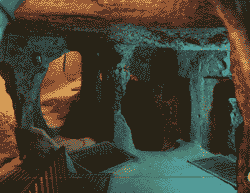
The earliest record of the name of Cappadocia dates from the late 6th century BC when it appears in the trilingual inscriptions of two early Achaemenid kings, Darius I and Xerxes, as one of the countries (Old Persian dahyu-) which are part of the Persian Empire. In these lists of countries the Old Persian name is Katpatuka, but it is clearly not a native Persian word. The Elamite and Akkadian language versions of the inscriptions contain a similar name from Akkadian katpa "side" (cf. Heb katef) and a chief or ancestor's name, Tuka.[2]
Herodotus tells us that the name of the Cappadocians was applied to them by the Persians, while they were termed by the Greeks "Syrians" or "White Syrians" (Leucosyri). One of the Cappadocian tribes he mentions are the Moschoi, associated by Flavius Josephus with the biblical figure Meshech, son of Japheth, "and the Mosocheni were founded by Mosoch; now they are Cappadocians". AotJ I:6. Also see Ketubot 13:11 in the Mishna.
Cappadocia is also mentioned in the Biblical account given in the book of Acts 2:9, with the Cappadocians being named as one of the people groups hearing the Gospel account from Galileans in their own language on the day of Pentecost shortly after the resurrection of Jesus Christ. Acts 2:5 seems to suggest that the Cappadocians in this account were "God-fearing Jews". See Acts of the Apostles.
Under the later kings of the Persian Empire they were divided into two satrapies, or governments, with one comprising the central and inland portion, to which the name of Cappadocia continued to be applied by Greek geographers, while the other was called Pontus. This division had already come about before the time of Xenophon. As after the fall of the Persian government the two provinces continued to be separate, the distinction was perpetuated, and the name Cappadocia came to be restricted to the inland province (sometimes called Great Cappadocia), which alone will be the focus of this article.
The kingdom of Cappadocia was still in existence in the time of Strabo as a nominally independent state. Cilicia was the name given to the district in which Caesarea, the capital of the whole country, was situated. The only two cities of Cappadocia considered by Strabo to deserve that appellation were Caesarea (originally known as Mazaca) and Tyana, not far from the foot of the Taurus.







